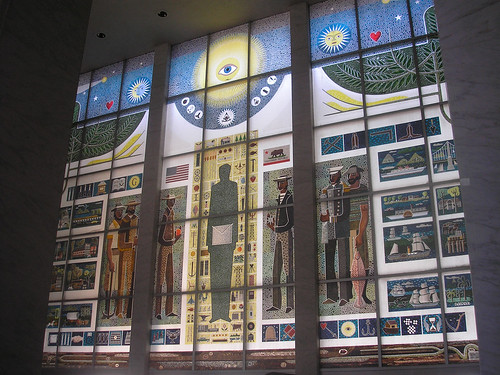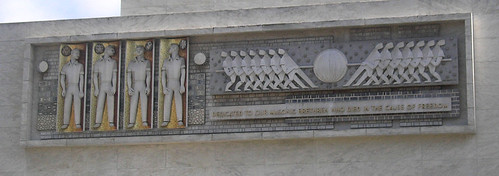
I haven’t said much on the subject of membership in Freemasonry (in general) and in the United States in particular, for some time. But with the buzz and interest in the last few posts (Freemasonry Is Dying, Bait & Switch, I Quit and Masonic Anti-Intellectualism A Crying Shame), I thought it necessary to pen a few thoughts on the matter.
So often articles like these end gathering comments saying “…lodges just need to do the work and things will get better…we need to guard the west gate” or “…we need to focus on the people with a real interest in Masonry.” I like “Freemasonry isn’t dying…we’re refining.”
In all of these instances, the insinuation of doing nothing except what was done before, only better, is tantamount to putting your head in the sand and pretending that the problem isn’t really a problem. This isn’t a new realization. I gave the numbers my own rudimentary examination in 2007, concluding with saying So What? You can’t stem the change without acknowledging it.
Read: Freemasonry after COVID
That change, no longer on the horizon, will only result in a better fraternity with true believers of likeminded men. Some Masons get it, or at least see why its so hard to have the conversation in the first place. And sure, Freemasonry as an entity, isn’t dying. What’s dying is the Freemasonry as we know it today.

The situation as I’m reading and seeing today in the numbers, is membership declining precipitously which will mean sooner, rather than later, revenue from lodges will dry up and lodges will close. This story ran just yesterday in the Daily Times, a news outlet out of Delaware County, PA: End of Era in Chester: Masons hold final meeting.
The long and the short of it: lodge membership dropped, it lost its charter, the Grand Lodge took the charter and keys of the lodge and sold it.
As things progress in this period of refinement, Grand Lodges will take possession of old charters and buildings, selling the latter in high-value markets to keep their own coffers full sustaining what remains of Grand Lodge programs and retirement homes.
As member dues continue to shrink, the relationship between the lodge and grand lodge will be reevaluated and charters will start being deconstructed, flowing back along their lines of dispensation. In that process, Freemasonry will cease to exist in a meaningful way in the manner it does today.
No more lodge buildings. No more organized charity. No more institutional presence, turning to vapor 300 years charity, initiation and enlightenment.
They’ll be a few folks around doing something like Freemasonry, but it won’t be in the manner it was today.
It’s actually a fascinating thought experiment to consider how the business end of things will transpire as revenue dries up.
Cause and Effect
This is the cause and effect of change. Change in membership numbers, change in interest, change in cultural norms.
Gone are the days of men in suits lunching on three martinis or fellas in blue collar work shirts building things in factories. The bygone days are gone.
Chris Hodapp posted a great piece on how the era of the “woke generation” has mostly forgotten about Freemasonry—seeing what’s left as an anachronistic throwback club wearing racially biased costumes in gender excluding male hang-outs (Read: Freemasonry in the Age of Woke). In some respects, the age of woke probably isn’t too far off the track on their assessment. You can see, in one instance, what happens to the temples when their caretakers have to turn over the keys because they can’t keep up the rent.
This is the change that’s happening, right now, as the number of dues-paying members declines.
Masonry is going to change, not because it wanted to, but mostly because it will run out of the fuel that sustains it—namely people and money.
History Repeats Itself
This isn’t the first time Freemasonry has faced change.
During the Morgan Affair, membership in Freemasonry recoiled and nearly went extinct in the fires of the Anti-Masonic Political Party. Over the centuries masons gathered in conclaves, held meetings, met in lodges, and traveled to regional congresses—all to debate the changes they faced and the direction they should move.
In one early period, a rough conglomeration of stand-alone lodges in England organized themselves in a tavern to become the United Grand Lodge of England and the progenitor of American Freemasonry.
This was change. And it meant bucking the convention of the age.
From its inception (and baring a few making-of Masons at sight) lodges have been the defacto entry point to membership. To be a mason, you join a lodge, which meant you joined Freemasonry.
But membership is exclusive. You join “a” lodge to facilitate your dues and catalog your membership, which in turn rolls up to the state level grand lodge which takes a portion of your dues to pay some leadership and finance its operation.
By operation I mean how it controls and distributes charters, funds homes, controls communications between states and works organizationally (albeit loosely) with the other states and appendant bodies to say who’s “regular”, and who’s not. Think of dues as an affiliation fee, or a tax. The more members a lodge has, the more it pays to the grand lodge. The fuller the coffers the more it can do.
Catalyst for Change
The issue with modern Freemasonry, as practiced today, isn’t wholly the teachings. It isn’t wholly the philosophy. It isn’t in the message or ideals.
Certainly, the history and cultural norms bring a measure of baggage in the broad exclusion of women and the history of racial separation. But these “issues” have evolved their own solutions within the system. The problem facing modern Freemasonry, and its decline in membership, is its membership model.
To require interested seekers to pay to join a lodge that offers no “intrinsic” value or no “tangible” service isn’t working.
Sure, by joining a lodge dues payers get access to an esoteric library (maybe), something we all use these days. Members get access to a Masonic funeral (if you stay current in dues for a set number of years). And, if you fit into the culture, you can develop good relationships with people (maybe) who are interested (mostly) in the same things you are. In-between you might get to eat or serve (maybe) decent meals, argue over paying the bills (out of the dues you’ve paid) and support closely associated charities that exist to give family of some members something to do other than attending lodge dinners.
This is a gross oversimplification of the Life Masonic, but in a nutshell this is the bread and butter of the Masonic lodge system.
Why lodges lose most newly made masons is that they join, see this process, lose the value proposition (or never find a place in the old boys club) and within a fairly set amount period of time, stop attending and stop paying dues.
The issue isn’t lodges. The Issue is who’s using them. Not the leadership. The issue is in the members. Without them, there isn’t a reason to exist.
Follow the Money
It’s this layer of non-paid dues that really amplifies the loss. (read: There’s a Hole in Our Bucket) It’s the cessation of dues-paying members that ramps up the attrition.
This is what is wrong with the current model of Freemasonry.
No better meals, no better educational programs or improved ritual performance is going to bring people back once they’ve walked away. How would they know unless someone reaches out to sell them on the improved value proposition?
Doing Freemasonry Differently
The situation is that being a mason is dependent on paying dues to a local lodge that just doesn’t offer a value proposition.
Is there a different model? A disruption of the death spiral?
I think a temporary solution could be a separate layer of membership tied to the state or perhaps a national body that removes the barrier of belonging to a local lodge and allow, if even for a few years, membership in Freemasonry to start to grow again. This would allow for a needed infusion of membership (and their dues) to cycle back into the craft something of value for the membership. What does that look like? Quarterly programs, some kind of media that’s interesting to new AND old Masons keeping them interested, rather than a cut and paste photocopied newsletters full of borrowed articles from around the web.
Freemasonry isn’t dying a natural death. Freemasonry is slowly strangling itself in the grip of suicidal inaction over the fear of its own history under the glare of modernity.
The system of dues making the mason at the local lodge level is the noose strangling what’s left of the fraternity.
The antiquated modalities of doing things the way they were done before, right down to how and where dues are paid, is a noose around Freemasonry’s neck as we watch the options escape us like the last gasps of life on the gallows.
Disrupting Freemasonry
Some quick thoughts worthy of exploration to do Freemasonry differently:
- Change the membership system from the old lodge dues and Grand Lodge tax system
- Eliminate the necessity of belonging to “a” lodge
- Invite SNPDs (suspension of nonpayment of dues) back into the fold under the “new” system of membership
- Craft quality content, relevant to the program, to keep the membership engaged (Think how the AARP, Scouts or even the NRA are engaging their audiences)
- Look hard at the issues of race and gender
- Reevaluate the state by state system of management.
If not, doing nothing will still track the decline in membership. Doing something differently? Maybe it can slow things down.
Initiations could be handled by extant lodges with exceptional ritual which would begin to help them thrive again with returning members not tied to one lodge by dues and nurtured in meaningful ways. It’s a change from what’s been done before, in control of the change rather than letting the change control the future. Appendant bodies could leverage their above and beyond the blue lodge activities, and masonry can remember what it was to be flush again.
It means taking control of the future and leaning into it—steering the chaos as best possible—rather than letting the chaos of change control where the fraternity is headed.
Winston Churchill said, “To improve is to change; to be perfect is to change often.” Freemasonry hasn’t changed in nearly a century. Now is the time to seek perfection, before it’s too late and Freemasonry really is dead.














